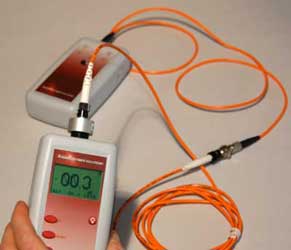OFDA Technology for In-Depth Fibre Quality Assessments
OFDA Technology for In-Depth Fibre Quality Assessments
Blog Article
Necessary Features to Look for in Optical Fibre Testing Equipment
When assessing optical fiber testing equipment, a number of essential features call for careful factor to consider to guarantee optimum performance and integrity. Compatibility with existing market standards improves functionality, while sophisticated measurement abilities, consisting of TDR and OTDR testing, deal essential insights right into network honesty. Recognizing these features will certainly shed light on how to select the ideal devices for your specific requirements.
Precision and Precision
Accuracy and accuracy are critical criteria in the evaluation of optical fiber screening equipment. These two attributes ensure that measurements show truth performance of fiber optic systems, which is vital for effective network setup, upkeep, and troubleshooting. Precision refers to the closeness of a measured value to the actual worth, while accuracy represents the repeatability of measurements under unchanged conditions.
When choosing optical fiber testing tools, it is necessary to think about tools that give high precision and accuracy to minimize errors in information interpretation. Gadgets such as optical time-domain reflectometers (OTDRs) and power meters must have calibration systems to make certain regular efficiency over time. Additionally, the specifications offered by makers must information the devices's measurement uncertainty, which directly impacts the reliability of test results.
Additionally, the performance of optical fibre testing devices can be affected by ecological variables, such as temperature level and moisture. Therefore, choosing tools made to minimize these variables will certainly improve measurement fidelity. In conclusion, purchasing optical fiber testing equipment with durable accuracy and precision attributes is essential for preserving optimal network efficiency and making certain the honesty of fibre optic interactions.

User-Friendly User Interface
The effectiveness of optical fiber screening equipment is not exclusively determined by its precision and accuracy; an easy to use user interface plays a significant duty in enhancing functional effectiveness. A properly designed user interface streamlines the communication in between the service technician and the tools, permitting a more intuitive understanding of intricate functions.
Trick features of an easy to use user interface consist of clear navigating food selections, logical layouts, and quickly obtainable controls. These elements enable service technicians to perform tests quickly without considerable training, decreasing the probability of customer mistake - ofda. Aesthetic indications such as progression bars, alerts, and visual depictions of information can dramatically boost the customer experience by giving prompt comments on the screening procedure.
Furthermore, adjustable settings can even more improve operations by allowing customers to readjust specifications according to specific screening needs. This flexibility not just saves time but also ensures that the equipment satisfies diverse application requirements.
Incorporating aid functions, such as tooltips and detailed handbooks, into the interface can further empower customers, promoting self-sufficiency and confidence in running the tools. Eventually, an user-friendly user try this web-site interface is important for maximizing the possibility of optical fibre screening devices, resulting in extra efficient and effective testing end results.
Portability and Durability
Transportability and durability are essential characteristics of optical fibre screening devices, ensuring that it can stand up to the roughness of various settings while remaining very easy to transportation. Specialists usually operate in diverse setups, from telecommunications hubs to remote installments, making it crucial that testing tools are light-weight and portable (ofda). Equipment developed with transportability in mind commonly includes ergonomic manages and instances that facilitate simple and easy motion, therefore improving operational effectiveness on-site
Longevity is equally vital, as optical fiber testing tools is commonly revealed to severe problems, consisting of temperature changes, moisture, and physical influences. Gadgets constructed with rugged products such as enhanced plastics or steel real estates are better suited for these atmospheres, decreasing the risk of damage during usage and transportation. Additionally, equipment with water and dust resistance ratings, such as IP ratings, guarantees reputable efficiency in difficult conditions.
Compatibility With Specifications
Ensuring compatibility with sector requirements is important for optical fibre testing devices, as it straight affects the integrity and legitimacy of examination results. Optical fiber networks undergo stringent efficiency standards established by various companies, including the Telecoms Sector Organization (TIA) and the International Electrotechnical Commission (IEC) Testing tools should abide by these criteria to make certain that measurements are constant and similar across different systems and link environments.
When picking optical fibre testing equipment, customers should confirm that the tool meets relevant criteria essential to their certain application, such as those pertaining to depletion, transmission capacity, and crosstalk. Devices that is certified with recognized requirements not just aids in achieving precise outcomes however also facilitates interoperability amongst gadgets from different producers.
Furthermore, compatibility with requirements makes sure that the tools can be used in governing conformity scenarios, which is critical for projects in industries such as telecommunications, aerospace, and army applications. Investing in optical fiber screening devices that lines up with existing industry requirements is a fundamental facet of preserving quality guarantee and accomplishing optimal network performance.
Advanced Dimension Capabilities
Advanced measurement capabilities are a specifying feature of contemporary optical fibre screening tools, enabling for thorough analysis of network performance. These capabilities make sure that specialists can review important specifications such as signal loss, dispersion, and bandwidth, which are vital for maintaining optimum interaction effectiveness.
One secret element is the capacity to carry out time-domain reflectometry (TDR) and optical time-domain reflectometry (OTDR) tests. These techniques allow users to identify faults, measure the size of fibers, and figure out the area of issues with impressive precision - ofda. Furthermore, advanced devices usually consists of the ability to determine optical power degrees, aiding to analyze the total wellness of the network and ensure conformity with the called for specifications.
In addition, some testing gadgets use innovative formulas for real-time analysis, allowing quicker medical diagnosis and troubleshooting. In final thought, investing in optical fiber testing devices with advanced measurement capabilities is essential for making sure network integrity and performance in today's demanding telecoms landscape.
Final Thought

Report this page